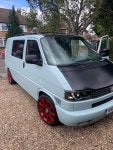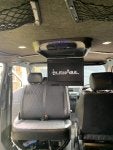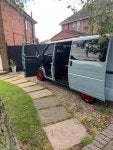I am no expert but can give you some details regarding buying a new t4.
Here are the tips that you can use to check before buying.
Body types
It was available in either short or long wheelbase in a variety of different body types”
- Pick up, either double (based on the LWB chassis, called ‘Doka’) or single cab.
- Van, panel (no windows), Kombi (just a single-window each side), Caravelle, or Multivan (windows all around).
- Roof options – standard, high top, elevating.
- Doors, either single or ‘barn door’ at the rear and single or double side sliding doors.
- Nose, either long or short, the long nose appearing in 1996. Known sometimes as T4a and T4b respectively.
- Syncro four-wheel-drive model offered with 2.4D, 2.5 petrol and 2.5TDi engines.
Body checks
T4 rust-proofing was a lot more effective than on the T25 so serious corrosion shouldn’t be a major issue, and things improved further still after the 1996 facelift. However, these are the T4’s worst-hit areas:
- The base of the screen, the wheel arches, lower sills, the bottom of the sliding door inside and out, and the metal around the fuel filler.
- Inner wings, chassis, and floor pan. Rust can also take hold around the rear cross member, just above where the rear springs locate.
- Check door seals are watertight, especially around the bottom of the tailgate.
- The sliding mechanism for the side door should be smooth and even; if the top rail is worn, the door can drop out so lift the door up and down to check for any play. It should also sit flush when closed, but there is some adjustment to get it fitting properly.
Engines
Petrol engines included: 1.8, 2.0, 2.5 five-cylinder, and the 2.8 VR6 which was also available in 170bhp 24-valve guise from 2000. The latter is lovely but thirsty unless you get one that’s had an LPG conversion.
Diesel: 1.9D, 1.9TD, and the 2.4D along with range-topping 2.5 five-cylinder TDi units which initially produced 88bhp (with blue ‘i’ badge), rising to 102 from 1995 (here with the ‘i’ in silver) and a stonking 151bhp from 1998, but only on German vans with the ‘i’ appearing in red.
The most desirable engine is the 2.5TDi – it’s pokey and will do 40mpg. It’s also relatively easy to convert the 88bhp unit to 102 by fitting a top-mounted intercooler and even 150bhp is within reach with tuning. The 68bhp 1.9TD is also a good bet – it’s not that quick but it’s tuneable and doesn’t command an as high price as the 2.5. Avoid the non-turbo diesel if you can.
Watch for:
- 2.4D head gasket issues.
- TDI timing belt replacement. Because the belt drives the water pump as well if the pump fails it will take out the belt at the same time. Make replacing the cambelt and water pump the first job you do.
- Dodgy synchros or cars that jump out of gear.
- Because the T4 has a hydraulic clutch, check for fluid leaks around the pedal box. Check there are no cracks in the pedal box itself where the clutch master cylinder mounts as this is another T4 foible.
Electrics/Interior
Make sure everything works as it should because trying to diagnose electrical niggles can be time-consuming and problems expensive to put right.
- Westy tank level sensors are prone to failure and are expensive to replace.
- Instrument clusters have a voltage regulator that can play up and cause erratic temp/fuel readings, though later models seem to suffer less.
- Check the wiring into the driver’s door which can chafe and fail, and that the central locking window regulators (if fitted) are all behaving themselves.
- Watch for faulty brake light switches and duff ignition switches.
Suspension/steering
Uneven tire wear indicates tired suspension bushes or a van that’s had its geometry put out by a smash.
- Knocks or clunks will usually indicate worn bottom ball joints, drop links, or anti-roll bar bushes.
- Noises from the rear are most likely the trailing arm bushes.
- Power steering was an option initially, although later vans should have it. Listen for groans or other nasty noises as you turn from lock to lock and check the fluid to ensure there have been no leaks.
Brakes
There are no real brake problems to beware of on the T4, so just do all the normal brake checks, namely:
- Eyeball the hydraulic pipes/hoses and make sure there’s no judder from warped discs.
- If a van pulls up to one side, suspect a seized rear caliper.
- Make sure the handbrake is effective; the cable can stick in its outer sleeve if a van’s been left standing for a while.
What to pay?
- Entry level = £2,000-£3,000 (panel van), £5,000 is the starting price for a half decent 2.5TDi.
- Camper conversions from the likes of Autosleeper will begin at £10,000, while really nice conversions from Reimo or Westfalia with a 2.5TDi under the bonnet could make as much as £12-£15k.
Top tips
- Buy a well-maintained works van which has been kept mechanically sound.
- Avoid heavily modified T4s – ones that have been ‘got at’.
- Rotten T4s only make sense if you can do all the work yourself.
- 2.5TDi is nice but there will be a premium to pay and because of its extra complexity. If things go wrong it will be more expensive to fix. With that in mind, the 1.9TD is perhaps a better bet, and it can also be run on veg/biofuel which could be a consideration.
- The bodywork condition is all-important. A really straight, original T4 is likely to appreciate in years to come.
I hope this will help you.
Cheers and happy buying...















